Best known in agricultural circles for its well-built skid steer loaders, Bobcat is a relatively new player to the agricultural telehandler market, especially in Ireland. The firm first entered the agricultural telescopic loader market in 2011 with two models. In the following years, it has increased its agricultural portfolio to seven telescopic loaders with three levels of specification.
Adare Farm Machinery in Co Limerick has been the Bobcat importer in Ireland since 2015. It has sold Bobcat telehandlers since then, though it was mainly construction machines until a new range of agri telehandlers was introduced in 2017/18. 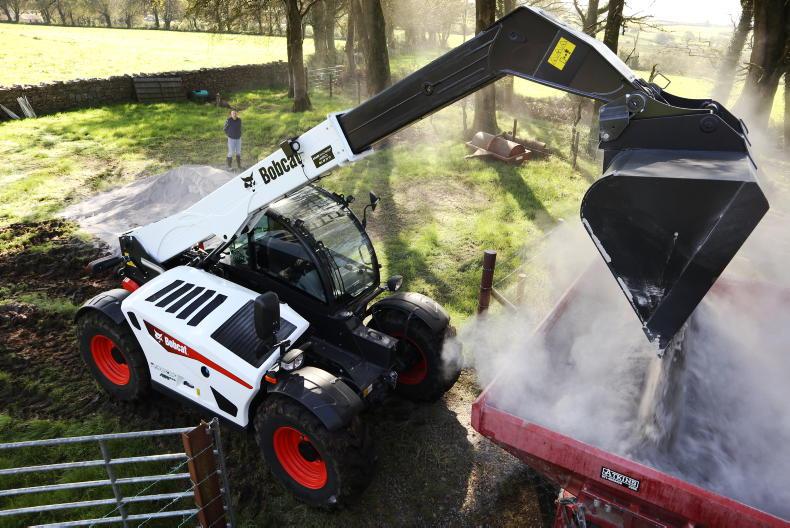
The machine has a hydrostatic transmission which is complemented by a two-speed mechanical gearbox, known as a hydro-mechanical box.
Bobcat telehandlers have been sold in Massey Ferguson livery for decades. The firm had previously sold its own branded handlers solely for the construction sector. Around three years ago, Bobcat decided to sell its own branded machines directly into the agricultural sector. The loaders are still available in Massey colours.

Bobcat first entered the agricultural telescopic loader market in 2011, initially introducing two models.
At first glance, the TL38.70HF is a well-built, impressive, modern-looking telehandler. Weighing 7,580kg, the model we tested was shod on 460/70 R24 Michelin XMCL tyres. The Bobcat range encompasses some impressive features as standard such as the automatic electric handbrake, a programmable reversing fan and a cushioning system on the boom retract.
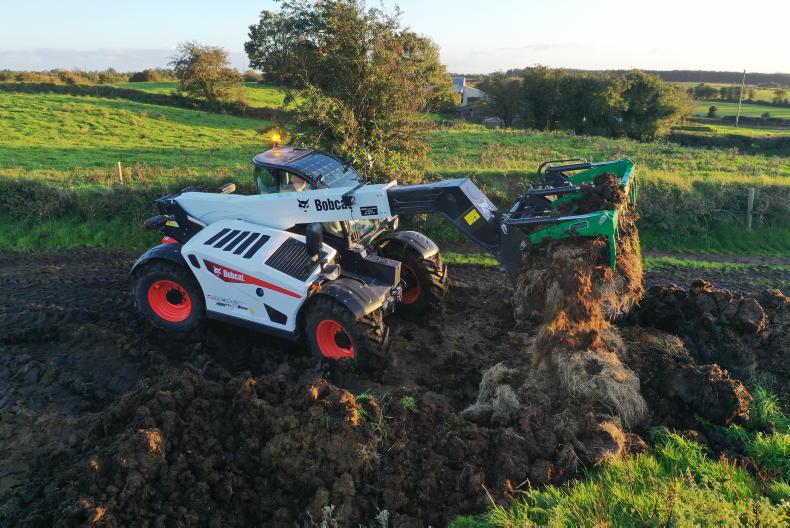
Weighing in at 7,580kg, the model that we tested was shod on 460/70 R24 Michelin XMCL tyres.
Engine
Since Bobcat was taken over by Doosan, the TL38.70HF now sports Bobcats in-house 3.4 litre engine. This four-pot powertrain generates 130hp (97kW). This engine is compliant with the Stage IV regulations. The engine has no diesel particle filter and uses Exhaust Gas Recirculation (EGR), Diesel Oxydation Catalyst (DOC) and Selective Catalytic Reduction (SCR).
The machine wasn’t left wanting for power, with the four-cylinder engine proving to be quite efficient on fuel and on AdBlue. The engine was also notably quiet. Once the single-piece bonnet is folded up, the air filters, oil filters, oil reservoirs and the radiator can be easily accessed for regular maintenance and servicing. 
Once the single piece bonnet is folded up, the air filters, oil filters, oil reservoirs and the radiator can be easily accessed
Previous agricultural telehandlers in the Bobcat range would have been powered by Deutz and Perkins engines.
A nice feature if using the machine in dusty environments such as grain stores is the changeable intervals for the hydraulic reversing fan. The fan inverter reverses the air flow without stopping the engine, cleaning the radiators and air intake grill. It can also be manually activated. Meanwhile, a creeper setting allows the operator to adjust revs independently of forward speed.
The telescopic loader has a load-sensing pump which supplies a sizeable 190l/min at 250 bars (150 l/min for the auxiliary line).
Transmission
The agri handler we tried has a hydrostatic transmission which is complemented by a two-speed mechanical gearbox, known as a hydro-mechanical box. A rocker switch on the dash is used to change between the two gear ranges. One slight disadvantage is that the machine has to be at a complete standstill before you can change ranges.

A nice feature useful in dusty environments is the changeable setting intervals for the hydraulic reversing fan.
Designed to offer higher torque when handling heavy materials, both first and second gears have a high and a low range. This is thanks to the two-speed hydrostatic motor (sourced from Danfoss) that can be changed on the move.
The telescopic loader is fitted with the reputable Italian manufactured Dana-Spicer axles. These heavy-duty axles have a central differential gear, service brakes in an oil bath, and three planetary gears in the hubs.
Hydraulics
The HF (high flow) technology feature on the TL38.70HF means the load-sensing pump supplies a sizeable 190l/min at 250 bars (150 l/min for the auxiliary line). The high flow feature means that when using the hydraulic functions simultaneously, the hydraulics still proved to be very fast. This was one of the standout features of the machine. We understand the hydraulic pump is sourced from Casappa.
Another tidy feature was the Fast Connect System, which allowed for the quick change of hydraulic attachments with its pressure-release system. Meanwhile, the Auxiliary Flow Management feature allows the operator to regulate the oil flow to the hydraulic attachments through the LCD screen in the cab.
The auto boom suspension uses a two-stage accumulator system, which allows it to adapt to different load sizes. The feature is managed according to the speed. When travelling over 5km/h, the feature is engaged but while travelling below 5km/h the suspension feature will be disengaged. The feature can be switched on or off using a button on the dash, or a button on the joystick which is handy. When travelling in difficult terrain with a load on the front, the boom suspension significantly improved ride comfort. 
The telescopic loader is fitted with the reputable Italian manufactured Dana-Spicer axles.
Another smart feature is the inclusion of a boom cushion, especially if the operator is not used to driving the machine. This allows for a smoother motion when the boom is close to minimum and maximum angles, or close to full retraction. It should also help to reduce wear and tear, as there’s a reduced sudden halting of steel on steel at high pressure. 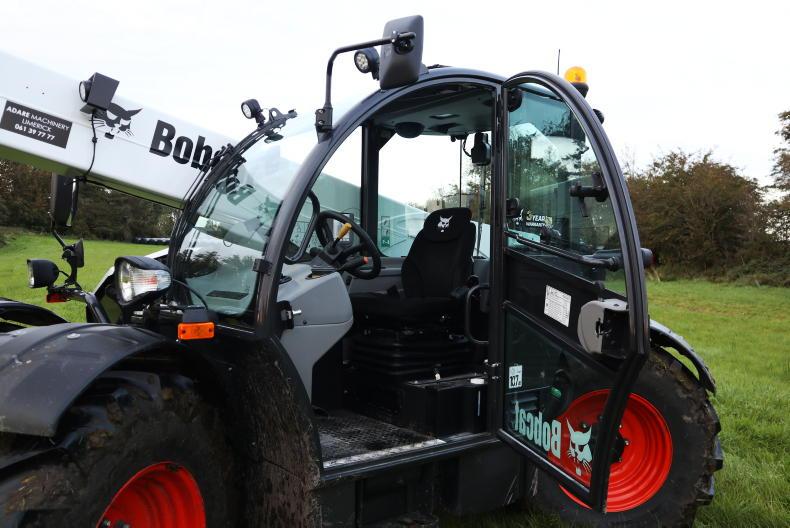
Despite the heavy presence of grey plastic inside the cab, it is presented as a pleasant working environment.
Cab
The cab in the TL38.70HF boasts a five-pillar design, with the rear back right post removed for increased visibility to the wheel. Overall visibility is good, but the bonnet to the right of the machine does slightly hinder visibility. For those working in environments with restricted heights, a low-profile cab can be availed of.
Despite the heavy presence of grey plastic in the cab, it is a pleasant working environment. For the most part, the controls are straightforward. As expected, the electro-proportional joystick controlled forward/neutral/reverse, all boom movements, the auxiliary controls and the machine setting controls including the boom suspension. 
As the forward/reverse shuttle is on the top of the joystick, in between the pushing out/retracting of the boom and the third service, it almost limits the possibility of carrying out more than one function at a time, as your thumb has to perform two tasks.
As the forward/reverse shuttle is on the top of the joystick, in between the pushing out/retracting of the boom and the third service, it almost limits the possibility of carrying out more than one function at a time, as your thumb has to perform two tasks. Perhaps the shuttle may have been better suited to the underside of the joystick, where the index finger could flick the shuttle into forward or reverse. Once driving, you notice how light the steering and the footbrake are, aiding ease of operation.<>
All machine functions are displayed on a multifunction LCD screen.
All machine functions are displayed on a multifunction LCD screen. For those looking to get the most from the handler in specific applications, some functions are hidden away in the screen and require a little bit of digging to uncover. These include the rate of oil flow to the third service, the creeper speed setting and the recurrent reversing fan setup.
A rocker switch on the dash is used to change between the two gear ranges.
Another standout feature we really liked was the automatic engaging and disengaging of the handbrake, comparable to what we have become accustomed to in modern cars. The handbrake will be automatically engaged when the machine is in neutral for three seconds. Similarly, it is also automatically engaged when the machine is at low engine revs or when the engine is turned off.
The telescopic loader has three different steering modes including two-wheel steer, four-wheel steer and crab steer. These modes can be easily changed with the switch of a button. A semi-automatic wheel alignment feature helps the operator to ensure the wheels are always aligned when changing between the three steering modes. Wheel re-alignment can also be made manually.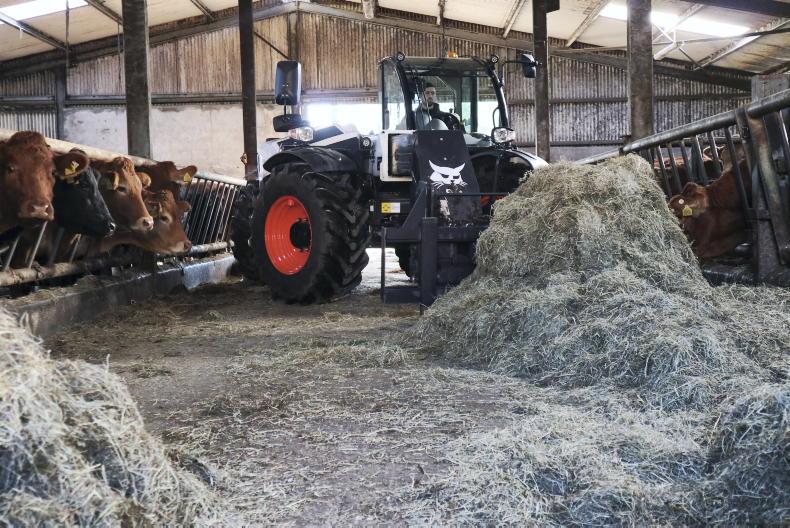
The TL38.70HF is a lively, capable machine. Its rugged build quality can’t be faulted. Its box-welded frame and components are well protected by the underbelly bottom plate, helping to give the operator piece of mind when working in the field.
The control layout in the cab is simple and easy to follow. The deeper you delve, the more smart functions and driving modes you uncover. The machine is packed with easy-to-use practical features that will aid the operator across a range of applications. Visibility for the most part is good. The removal of the back rear corner post is welcome.
The major draw to a Bobcat agricultural telehandler for any potential buyer currently in the market for such a machine has to be the current five years or 5,000 hour warranty which the firm is offering. With the cost of modern machinery, operators need to have a fixed-cost system when possible.
Overall, despite being a relatively newcomer to the market, we feel Bobcat is offering a solid product packed with intuitive smart features which is sure to be a thorn in the side of the current market leaders.
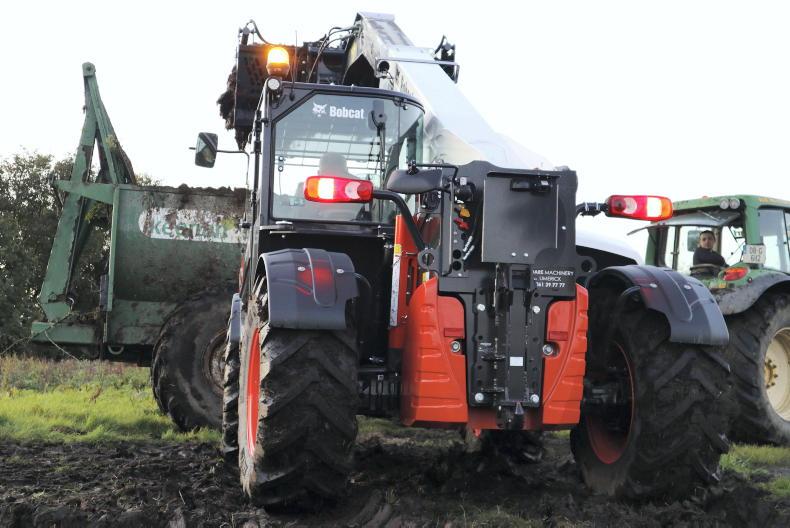
The spec
Engine: 3.4l Bobcat four-cylinder Stage IV.
Horsepower: 130hp (97kW).
Transmission: Hydrostatic motor with two-speed gearbox.
Max lifting capacity: 3,800 kg.
Max lift height:
6.97m.
Travel speed: 40km/h.
Hydraulic output: 190l/min (150 l/min for the auxiliary line).
Weight (unladen): 7,580kg.
Diesel tank: 138 litres.
Tyres: Michelin 460/70 R24.
List price: €78,000 plus VAT.
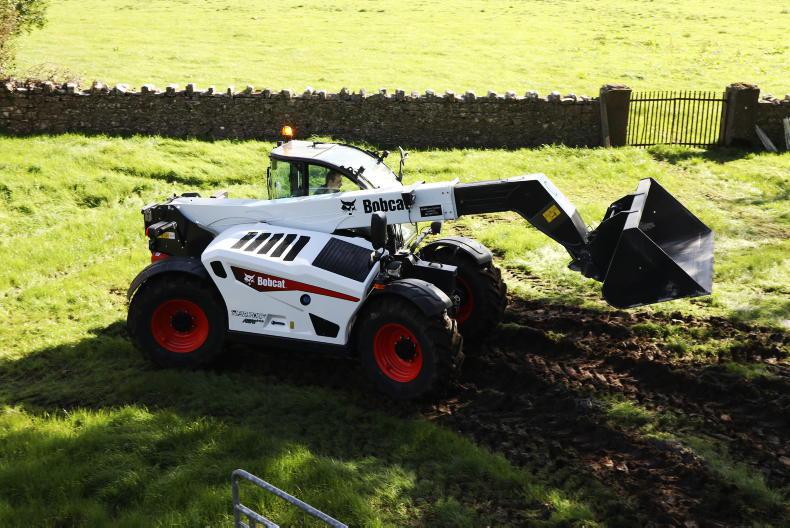
Best known in agricultural circles for its well-built skid steer loaders, Bobcat is a relatively new player to the agricultural telehandler market, especially in Ireland. The firm first entered the agricultural telescopic loader market in 2011 with two models. In the following years, it has increased its agricultural portfolio to seven telescopic loaders with three levels of specification.
Adare Farm Machinery in Co Limerick has been the Bobcat importer in Ireland since 2015. It has sold Bobcat telehandlers since then, though it was mainly construction machines until a new range of agri telehandlers was introduced in 2017/18. 
The machine has a hydrostatic transmission which is complemented by a two-speed mechanical gearbox, known as a hydro-mechanical box.
Bobcat telehandlers have been sold in Massey Ferguson livery for decades. The firm had previously sold its own branded handlers solely for the construction sector. Around three years ago, Bobcat decided to sell its own branded machines directly into the agricultural sector. The loaders are still available in Massey colours.

Bobcat first entered the agricultural telescopic loader market in 2011, initially introducing two models.
At first glance, the TL38.70HF is a well-built, impressive, modern-looking telehandler. Weighing 7,580kg, the model we tested was shod on 460/70 R24 Michelin XMCL tyres. The Bobcat range encompasses some impressive features as standard such as the automatic electric handbrake, a programmable reversing fan and a cushioning system on the boom retract.

Weighing in at 7,580kg, the model that we tested was shod on 460/70 R24 Michelin XMCL tyres.
Engine
Since Bobcat was taken over by Doosan, the TL38.70HF now sports Bobcats in-house 3.4 litre engine. This four-pot powertrain generates 130hp (97kW). This engine is compliant with the Stage IV regulations. The engine has no diesel particle filter and uses Exhaust Gas Recirculation (EGR), Diesel Oxydation Catalyst (DOC) and Selective Catalytic Reduction (SCR).
The machine wasn’t left wanting for power, with the four-cylinder engine proving to be quite efficient on fuel and on AdBlue. The engine was also notably quiet. Once the single-piece bonnet is folded up, the air filters, oil filters, oil reservoirs and the radiator can be easily accessed for regular maintenance and servicing. 
Once the single piece bonnet is folded up, the air filters, oil filters, oil reservoirs and the radiator can be easily accessed
Previous agricultural telehandlers in the Bobcat range would have been powered by Deutz and Perkins engines.
A nice feature if using the machine in dusty environments such as grain stores is the changeable intervals for the hydraulic reversing fan. The fan inverter reverses the air flow without stopping the engine, cleaning the radiators and air intake grill. It can also be manually activated. Meanwhile, a creeper setting allows the operator to adjust revs independently of forward speed.
The telescopic loader has a load-sensing pump which supplies a sizeable 190l/min at 250 bars (150 l/min for the auxiliary line).
Transmission
The agri handler we tried has a hydrostatic transmission which is complemented by a two-speed mechanical gearbox, known as a hydro-mechanical box. A rocker switch on the dash is used to change between the two gear ranges. One slight disadvantage is that the machine has to be at a complete standstill before you can change ranges.

A nice feature useful in dusty environments is the changeable setting intervals for the hydraulic reversing fan.
Designed to offer higher torque when handling heavy materials, both first and second gears have a high and a low range. This is thanks to the two-speed hydrostatic motor (sourced from Danfoss) that can be changed on the move.
The telescopic loader is fitted with the reputable Italian manufactured Dana-Spicer axles. These heavy-duty axles have a central differential gear, service brakes in an oil bath, and three planetary gears in the hubs.
Hydraulics
The HF (high flow) technology feature on the TL38.70HF means the load-sensing pump supplies a sizeable 190l/min at 250 bars (150 l/min for the auxiliary line). The high flow feature means that when using the hydraulic functions simultaneously, the hydraulics still proved to be very fast. This was one of the standout features of the machine. We understand the hydraulic pump is sourced from Casappa.
Another tidy feature was the Fast Connect System, which allowed for the quick change of hydraulic attachments with its pressure-release system. Meanwhile, the Auxiliary Flow Management feature allows the operator to regulate the oil flow to the hydraulic attachments through the LCD screen in the cab.
The auto boom suspension uses a two-stage accumulator system, which allows it to adapt to different load sizes. The feature is managed according to the speed. When travelling over 5km/h, the feature is engaged but while travelling below 5km/h the suspension feature will be disengaged. The feature can be switched on or off using a button on the dash, or a button on the joystick which is handy. When travelling in difficult terrain with a load on the front, the boom suspension significantly improved ride comfort. 
The telescopic loader is fitted with the reputable Italian manufactured Dana-Spicer axles.
Another smart feature is the inclusion of a boom cushion, especially if the operator is not used to driving the machine. This allows for a smoother motion when the boom is close to minimum and maximum angles, or close to full retraction. It should also help to reduce wear and tear, as there’s a reduced sudden halting of steel on steel at high pressure. 
Despite the heavy presence of grey plastic inside the cab, it is presented as a pleasant working environment.
Cab
The cab in the TL38.70HF boasts a five-pillar design, with the rear back right post removed for increased visibility to the wheel. Overall visibility is good, but the bonnet to the right of the machine does slightly hinder visibility. For those working in environments with restricted heights, a low-profile cab can be availed of.
Despite the heavy presence of grey plastic in the cab, it is a pleasant working environment. For the most part, the controls are straightforward. As expected, the electro-proportional joystick controlled forward/neutral/reverse, all boom movements, the auxiliary controls and the machine setting controls including the boom suspension. 
As the forward/reverse shuttle is on the top of the joystick, in between the pushing out/retracting of the boom and the third service, it almost limits the possibility of carrying out more than one function at a time, as your thumb has to perform two tasks.
As the forward/reverse shuttle is on the top of the joystick, in between the pushing out/retracting of the boom and the third service, it almost limits the possibility of carrying out more than one function at a time, as your thumb has to perform two tasks. Perhaps the shuttle may have been better suited to the underside of the joystick, where the index finger could flick the shuttle into forward or reverse. Once driving, you notice how light the steering and the footbrake are, aiding ease of operation.<>
All machine functions are displayed on a multifunction LCD screen.
All machine functions are displayed on a multifunction LCD screen. For those looking to get the most from the handler in specific applications, some functions are hidden away in the screen and require a little bit of digging to uncover. These include the rate of oil flow to the third service, the creeper speed setting and the recurrent reversing fan setup.
A rocker switch on the dash is used to change between the two gear ranges.
Another standout feature we really liked was the automatic engaging and disengaging of the handbrake, comparable to what we have become accustomed to in modern cars. The handbrake will be automatically engaged when the machine is in neutral for three seconds. Similarly, it is also automatically engaged when the machine is at low engine revs or when the engine is turned off.
The telescopic loader has three different steering modes including two-wheel steer, four-wheel steer and crab steer. These modes can be easily changed with the switch of a button. A semi-automatic wheel alignment feature helps the operator to ensure the wheels are always aligned when changing between the three steering modes. Wheel re-alignment can also be made manually.
The TL38.70HF is a lively, capable machine. Its rugged build quality can’t be faulted. Its box-welded frame and components are well protected by the underbelly bottom plate, helping to give the operator piece of mind when working in the field.
The control layout in the cab is simple and easy to follow. The deeper you delve, the more smart functions and driving modes you uncover. The machine is packed with easy-to-use practical features that will aid the operator across a range of applications. Visibility for the most part is good. The removal of the back rear corner post is welcome.
The major draw to a Bobcat agricultural telehandler for any potential buyer currently in the market for such a machine has to be the current five years or 5,000 hour warranty which the firm is offering. With the cost of modern machinery, operators need to have a fixed-cost system when possible.
Overall, despite being a relatively newcomer to the market, we feel Bobcat is offering a solid product packed with intuitive smart features which is sure to be a thorn in the side of the current market leaders.

The spec
Engine: 3.4l Bobcat four-cylinder Stage IV.
Horsepower: 130hp (97kW).
Transmission: Hydrostatic motor with two-speed gearbox.
Max lifting capacity: 3,800 kg.
Max lift height:
6.97m.
Travel speed: 40km/h.
Hydraulic output: 190l/min (150 l/min for the auxiliary line).
Weight (unladen): 7,580kg.
Diesel tank: 138 litres.
Tyres: Michelin 460/70 R24.
List price: €78,000 plus VAT.






















 This is a subscriber-only article
This is a subscriber-only article





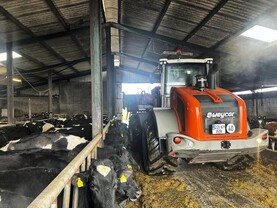



SHARING OPTIONS: